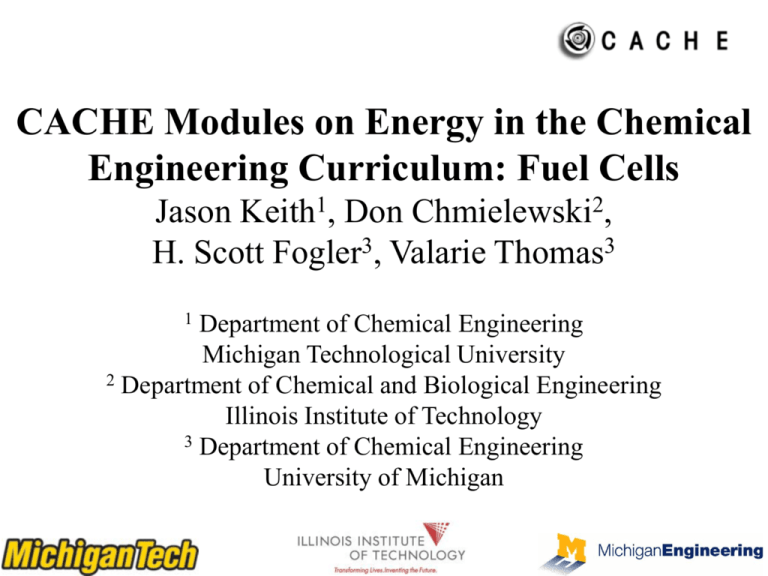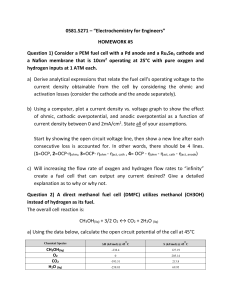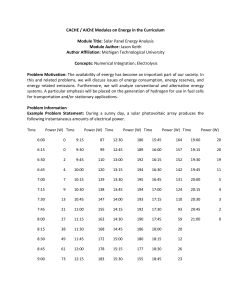Fuel Cells
advertisement

CACHE Modules on Energy in the Chemical Engineering Curriculum: Fuel Cells Jason Keith1, Don Chmielewski2, H. Scott Fogler3, Valarie Thomas3 1 Department of Chemical Engineering Michigan Technological University 2 Department of Chemical and Biological Engineering Illinois Institute of Technology 3 Department of Chemical Engineering University of Michigan Outline • • • • • • Introduction and Motivation What is in each module? Where are the modules? What are the modules? Module walk-through Conclusions / Acknowledgments Introduction and Motivation • Alternative energy component missing from most departments • Fuel Cells have been discussed in the political arena as an alternative energy solution – Need to educate ChE’s in this area • Growth in number of fuel cell textbooks – Most do not have homework problems • Modules can rapidly infuse new technologies into the Chemical Engineering Curriculum What is in each module? • Problem motivation • Reference to related sections and pages in popular ChE texts • Example problem statement • Example problem solution • Home problem statement • Home problem solution • Link to web resources • Non-ChE textbook resources • Notes to instructor Where are the modules? • Current beta test website: http://www.chem.mtu.edu/~jmkeith/fuel_cell_curriculum • Currently available for use by anyone! • Ultimately linked through CACHE website What are the modules? • Mass and Energy Balances – Application of Heat of Reaction: Hydrogen vs. Gasoline – Material Balances on a Fuel Cell – Energy Balances on a Fuel Cell – Generation of Electricity Using Recovered Hydrogen What are the modules? • Thermodynamics – Equation of State for Fuel Cell Gases – Thermodynamics and Fuel Cell Efficiency – Vapor Pressure / Humidity for Fuel Cell Gases • Fluid Mechanics – Friction Factor in Bipolar Plate Channel What are the modules? • Heat and Mass Transport – Conduction and Convection Heat Transfer in Fuel Cells – Microscopic Balances Applied to Fuel Cells – Diffusion Coefficients for Fuel Cell Gases • Kinetics and Reaction Engineering – Nernst Equation and Fuel Cell Kinetics – Using Plug Flow Reactor Equations for Fuel Cell Voltages Module walk-through • How long can you power a laptop computer with a type K hydrogen cylinder (49.9 L)? Computer (Electric Load) H2 feed line Air in Anode Gas Chamber Cathode Gas Chamber H2 and H2O out H2 tank Fuel Cell Air out Module walk-through Course: Material and Energy Balances (Stoichiometery) Title: Application of Heat of Reaction: Hydrogen versus gasoline Motivation: Use the heat of reaction to determine the energy contained in a hydrogen cylinder, and determine the equivalent number of gallons of gasoline. Reference: Felder and Rousseau, Section 4.6(3rd ed.) Each module has reference to popular text(s) for the course Module Example Problem Each example has an easy to follow step-by-step approach Example Problem: Determine energy generated for the combustion of a gallon of gasoline • Step 1) Determine DHr for gasoline components DHr,C7H16 = 7 DHCO2 + 8 DHH2O - DHC7H16 – 11 DHO2 DHr,C7H16 = -4816 kJ/mol • Step 2) Similarly: DHr,C8H18 = -5461 kJ/mol Module Example Solution • Step 3) Weighted average (87% n-heptane and 13% isooctane): DHr,gas = -5370 kJ/mol • Step 4) Determine mass in grams of components in 1 mol of gasoline: 13.0 g n-heptane and 99.2 g isooctane • Step 5) Determine volume of these components: The total volume is 162 cm3 or 0.043 gal • Step 6) Determine energy per gallon: -5370 kJ/mol /(1 mol/0.043 gal) = -125,000 kJ/gal Module Hwk Problem • How many kJ are there in a K cylinder of H2? • How many gallons of gas is this equivalent to? • How many gallons of water do you make from the hydrogen in the gas cylinder? • What is the maximum time you could power a 100 W laptop with this H2 cylinder? Module Hwk Solution • Currently open to everyone; final version will be password protected • Recommend printing example and statement and giving to students as a handout • How many kJ are there in a K cylinder of H2? Assume liquid water product, DHr,H2O = -286 kJ/mol From ideal gas law, cylinder contains n = 278 mol Energy content = -n DHr,H2O = 79000 kJ • Rest of step-by-step solution available at end of talk Conclusions / Acknowledgments • Fuel Cell Modules are for your use! • Contact one of the authors to participate • Acknowledgments of Partial Support: – CACHE Corporation – JMK: DOE(DE-FG02-04ER63821), NSF(DMI-0456537), and the Michigan Space Grant Consortium – DJC: Argonne National Laboratory – HSF / VT: Vennema Professorship and Thurnau Professorship Module Hwk Solution • How many kJ are there in a K cylinder of H2? Assume liquid water product, DHr,H2O = -286 kJ/mol From ideal gas law, cylinder contains n = 278 mol Energy content = -n DHr,H2O = 79000 kJ Module Hwk Solution • How many gallons of gas is this equivalent to? Assume 112 g/mol and density 0.69 g/cm3 Recall gasoline heat of reaction = -5370 kJ/mol Thus, hydrogen cylinder is equivalent to 14.7 mol gasoline Converting to mass we have 1646 g and then converting to volume gives 0.63 gal Module Hwk Solution • How many gallons of water do you make in a fuel cell? Stoichiometry tells us 278 mol of H2 react to form 278 mol H2O This is equivalent to 5000 g or 1.32 gal Module Hwk Solution • What is the maximum time you could power a 100 W laptop with this H2 cylinder? To determine the upper bound on time we assume all hydrogen is converted into electricity (100% efficiency). At a power of 100 W, 79000 kJ of energy would be consumed in 219 hours. In reality, you could expect the fuel cell to operate for 100 hours.






